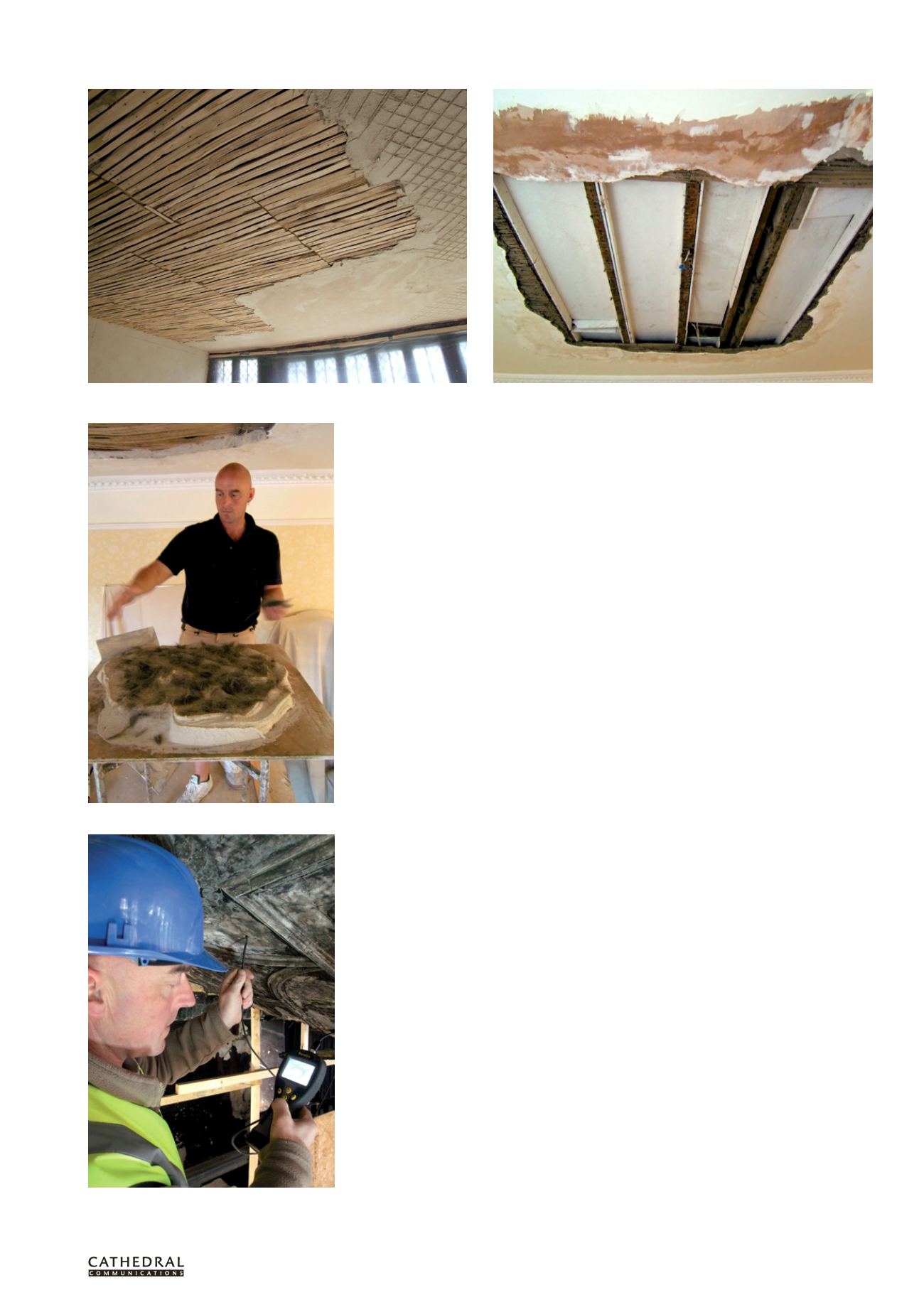
T W E N T Y F I R S T E D I T I O N
T H E B U I L D I N G C O N S E R VAT I O N D I R E C T O R Y 2 0 1 4
1 6 9
INTERIORS
5
At this point it will hopefully be possible
to assess the cause of the damage and plan
the appropriate repairs.
There are several different types of
timber failure:
• principal joist decay caused by
woodworm, wet or dry rot
• lath failure, commonly caused by
insect infestation or wet/dry rot
• nail failure – wrought iron nails may rust
and fail because the surrounding timber
is damp or due to prolonged exposure to
the tannins in green oak; the presence
of rusting fixings may be indicated by
stains on the underside of the ceiling
• fire damage will be self-evident but if
there is no damage to structural timbers it
may just be a case of a thorough clean up
• water damage from leaking pipes may
cause wet rot and gradual bowing of
the ceiling; the continued presence of
moisture will cause salt and mineral
migration which will eventually break
down the integrity of the plaster
and cause blowing (detachment of
the plaster from the substrate)
• water damage from burst pipes is likely
to cause the partial or total collapse
of the ceiling as the increased weight
of the saturated plaster is often too
much for the ageing laths to bear.
REPAIR TECHNIQUES
If the ceiling is in a listed building then all
work will require approval and or guidance
from the local conservation officer. It will
also be necessary to determine whether
gypsum or lime plaster was used so that
appropriate repair techniques can be
selected. Knowing the age of the ceiling
can be helpful here, but the form of any
modelling provides another useful clue,
since gypsum hardens quickly, enabling
sharper details on sculptural decoration.
The first priority in the case of a bowed
or partially collapsed ceiling is to support
it from below using soft matting to avoid
damaging the face of the ceiling. The matting
should be held in place with plywood and
planks supported by adjustable props. Sheep’s
wool insulation is ideal for soft propping as it
New lath and plaster ceiling showing staggered lath joints and pricking-up coat
Adding hair to lime mortar
Lath and plaster ceiling which collapsed after fire-proofing was installed from above
be run on a bench and stuck in place. The
decorative enrichments would have been
cast using a carved wooden reverse mould or
a wax mould. Later on, gelatine and rubber
moulds were introduced.
The finishing coat was one part lime
putty to one part fine sand or two parts lime
putty to three parts fine sand to a thickness
of 2–5mm (�∕ ₁₆"–3 ∕₁₆"), sometimes with the
addition of fine short chopped goat hair.
Earth backing coats were used
extensively in early plastered ceilings.
Animal hair or chopped hay would be added
to give tensile strength to the material when
dry. Lime putty and fine sand were commonly
used as the finishing coat.
TYPICAL DEFECTS
Probably the most common causes of
collapse or damage to any ceiling, historical
or otherwise, are:
• timber failure
• installation of new services
• installation of fire-proofing material
• fire damage
• water damage
• damp/wet rot
• dry rot
• insect infestation
Before any repairs can be undertaken the
cause of the damage should be determined
and rectified. Many ceilings that look
irreparable can be saved.
If the cause of the cracking or collapse
is not immediately apparent it could be that
the timber supports are defective. If possible,
ask someone to walk on the floor above to see
if there is any flex in the ceiling timbers. It
could be that the timbers used were not the
right size for the job in hand. Also, if there is
a crack in the ceiling look for evidence of dust
continually appearing below it. This may also
indicate joist movement.
In order to further assess the ceiling
it is best to look at the back of the ceiling,
either by carefully removing the floor boards
in the room above or by accessing the loft
space. A digital inspection camera is a very
useful alternative, although this will mean
drilling 8mm holes for the insertion of the
camera lens.
Using a digital inspection camera


